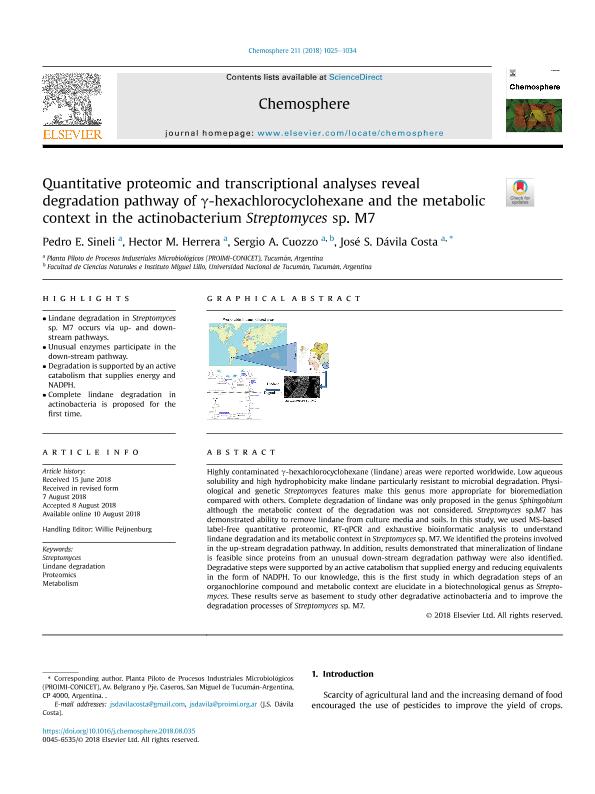Artículo
Quantitative proteomic and transcriptional analyses reveal degradation pathway of γ- hexachlorocyclohexane and the metabolic context in the actinobacterium Streptomyces sp. M7
Sineli, Pedro Eugenio ; Herrera, Héctor Matías; Cuozzo, Sergio Antonio
; Herrera, Héctor Matías; Cuozzo, Sergio Antonio ; Dávila Costa, José Sebastián
; Dávila Costa, José Sebastián
 ; Herrera, Héctor Matías; Cuozzo, Sergio Antonio
; Herrera, Héctor Matías; Cuozzo, Sergio Antonio ; Dávila Costa, José Sebastián
; Dávila Costa, José Sebastián
Fecha de publicación:
07/2018
Editorial:
Pergamon-Elsevier Science Ltd
Revista:
Chemosphere
ISSN:
0045-6535
Idioma:
Inglés
Tipo de recurso:
Artículo publicado
Clasificación temática:
Resumen
Highly γ-hexachlorocyclohexane (lindane) contaminated areaswere reported worldwide. Low aqueous solubility and high hydrophobicitymake lindane particularly resistant to microbial degradation.Physiological and genetic Streptomyces features make this genus moreappropriate for bioremediation compared with others. Complete degradationof lindane was only proposed in the genus Sphingobium although themetabolic context of the degradation was not considered. Streptomyces sp.M7 has demonstrated ability to remove lindane from culture media andsoils. In this study, we used MS-based label-free quantitative proteomic,RT-qPCR and exhaustive bioinformatic analysis to understand lindanedegradation and its metabolic context in Streptomyces sp. M7. Weidentified the proteins involved in the up-stream degradation pathway. Inaddition, results demonstrated that mineralization of lindane is feasiblesince proteins from an unusual down-stream degradation pathway were alsoidentified. Degradative steps were supported by an active catabolism thatsupplied energy and reducing equivalents in the form of NADPH. To ourknowledge, this is the first study in which degradation steps of anorganochlorine compound and metabolic context are elucidate in abiotechnological genus as Streptomyces. These results serve as basementto study other degradative actinobacteria and to improve the degradationprocesses of Streptomyces sp. M7.
Palabras clave:
STREPTOMYCES
,
LINDANE
,
PROTEOMIC DEGRADATION
,
METABOLISM
Archivos asociados
Licencia
Identificadores
Colecciones
Articulos(PROIMI)
Articulos de PLANTA PILOTO DE PROC.IND.MICROBIOLOGICOS (I)
Articulos de PLANTA PILOTO DE PROC.IND.MICROBIOLOGICOS (I)
Citación
Sineli, Pedro Eugenio; Herrera, Héctor Matías; Cuozzo, Sergio Antonio; Dávila Costa, José Sebastián; Quantitative proteomic and transcriptional analyses reveal degradation pathway of γ- hexachlorocyclohexane and the metabolic context in the actinobacterium Streptomyces sp. M7; Pergamon-Elsevier Science Ltd; Chemosphere; 211; 7-2018; 1025-1034
Compartir
Altmétricas



